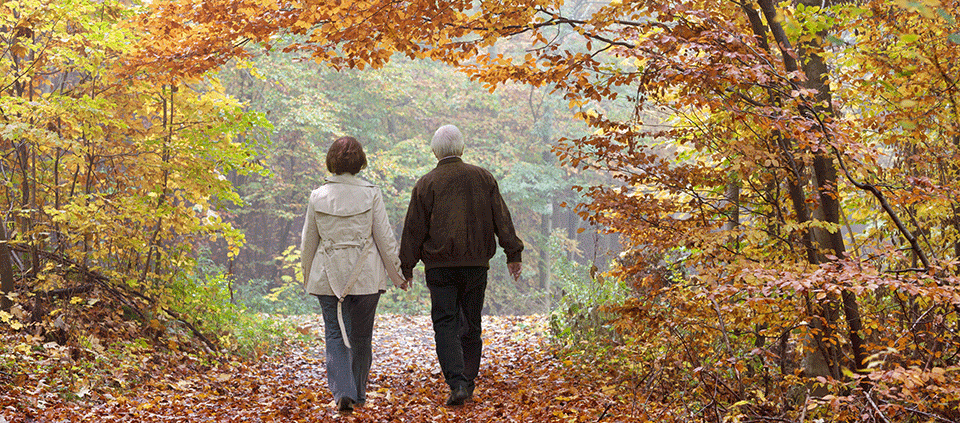10 Tips for Aging Dynamically

What if I told you that it’s possible to not only maintain your strength and mobility, but also improve them, no matter how old you are, by moving differently? What if you could walk greater distances, over hills and roots and cobblestones, with more stability, and have better balance and strength and less pain now than you did 20 years ago?
For the last 20 years, I’ve been working with people of all ages to help them do just this, including my four Dynamic Aging coauthors, who went from being severely limited by pain and lack of mobility to hiking for miles, walking everywhere, and even climbing trees.
Here are some tips I’ve found to be easy and impactful.
- Add in short bouts of walking. Yes, drive-through banks and drive-through coffee are convenient, but they also require less movement. Taking the easier way won’t help you maintain your strength and ability—it can actually cause you to lose it. Long walks aren’t the only way to reap the benefits of walking, so reclaim those short strolls whenever you can.
- Stretch your calves. The mobility and strength of your calf muscles are affecting your entire body, every step you take. Prioritize this simple Calf Stretch exercise, designed to lengthen and strengthen your stride, a few times a day. Place a rolled towel or yoga mat on the floor in front of you. Place the ball of your right foot on top and drop your heel on the floor. Step your left foot forward, keeping the right heel down and your torso upright. Keep both legs straight (no bent knees). Hold for 30 seconds and then switch legs.
- Strengthen your hips. Because of all the sitting even regular exercisers do, the main balance/strength muscles of a stable gait are often entirely sedentary. The Pelvic List exercise—a move that targets the muscles on the outside of the hip—is key to aging dynamically. No more wobbly hips, knees, and ankles! Here’s how to do it: Standing with both legs straight, holding a wall or chair for balance if necessary, push down with your left leg to raise your right leg up. Don’t hike the right leg up with your lower back or bend either knee—let the work come from your left hip muscles. Hold for 30 seconds and then switch sides.
- Reach your arms up and overhead. Arms, in our tech-rich world, are barely used for anything more than operating a computer. To move them more (and stretch your shoulders and chest at the same time) reach up to the top or sides of a doorway every time you walk through it and pause for a few seconds to stretch these important muscles.
- Heal your soles. Did you know that more than 25 percent of our muscles and bones are in our ankles and feet? In our constrictive-shoe-wearing, flat-and-level-surface-walking culture, many of our foot parts are never moved. Clear a safe barefoot area and start wiggling and lifting your toes. Spread them as far apart as possible and roll the bottoms of your feet on a tennis ball to start waking up sleepy feet.
- Go green (and blue). Nature, most easily accessed through parks, has green (trees, grass, and bumpy paths) and blue (water), and being around those things improves health. Take your movement out into nature as often as you can—even if that means sitting on a bench and meditating on the pond in front of you. Or, if you’re up for something a little more dynamic, nature offers varied surfaces to walk over, to test out and improve your balance.
- Make your kitchen less convenient. When your kitchen is full of electronic devices and all your dishes are easy to reach, it’s convenient, but it also means less movement. Start using your hands to knead bread dough, operate a can opener, and chop your veggies. Move dishes and ingredients that you use daily to lower or higher cupboards to encourage daily bending, twisting, and reaching.
- Sit in different ways. Scoot toward the front of the chair and don’t use the backrest, or sit on the floor, or sit on a stack of cushions on the floor, so you move your hips and knees through different angles each day. And that work you do to get up and down counts towards keeping your body strong.
- Move with friends. Turn your social time into movement and socializing time. Instead of meeting for coffee, meet for a walk through your local park. Suggest a dynamic book club meeting where you discuss your favorite read on the go.
- Be kind, especially to yourself, and grateful for small changes. Remember how many years it took you to get your body in its current condition, and encourage yourself the way you would any dear friend. Remember there is no miracle cure or “turning back the clock”—there’s just moving a bit more and a bit better every single day, until you find yourself confident enough to move over textured terrain, strong enough to play with your family, and capable of hiking for miles with friends—and even climbing a tree or two.
Find out about upcoming programs with Katy Bowman.
Katy Bowman is a biomechanist, award-winning author, and leader in the Movement movement. Through her website, podcast, books, and live classes and events, she reaches hundreds of thousands of people every month. Her eight books include the best-selling Move Your DNA, Movement Matters, and her latest, Dynamic Aging, which she co-wrote with four septuagenarians who began working with her in their 60s (and are now climbing trees).
© Kripalu Center for Yoga & Health. All rights reserved. To request permission to reprint, please e-mail editor@kripalu.org.
Katy Bowman, biomechanist, movement teacher, and best-selling author of eight books, including Dynamic Aging, works to support the reintegration of movement into human lives.
Full Bio and Programs